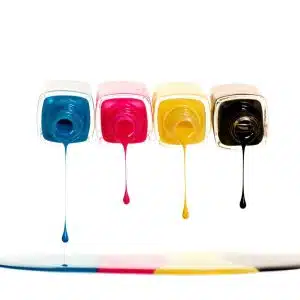What is silicone? Silicone is often confused with silicon. Silicon is not silicone. Silicone, a synthetic polymer, originates from silicon, a naturally occurring chemical element. The combination of silicon, oxygen, carbon, and hydrogen forms the silicone polymer. In this article, we will review silicone rubber printing with various inks.
Silicone ink vs Silicon ink, what is the difference?
Silicon Ink is a cost-effective nanotechnology-based product that improves the conversion efficiency of silicon solar cells in the manufacturing environment. Conversely, silicone inks utilize silicone polymer, a silicon derivative, for printing on textiles and silicone rubber. Boston Industrial Solutions, Inc. manufactures and supplies various types of silicone screen printing inks.
Silicone rubber is a sustainable material that is resistant to many environmental factors, such as heat, electricity, chemicals, ozone radiation, x-rays, etc. These properties make this material very useful for many applications. To print on these materials, you need silicone-based ink. Only silicone ink can bond to silicone rubber material. The performance of silicone inks on silicone surfaces is very good. However, as of now, it is not possible to digitally print with silicone inks.
Challenges of silicone printing
Screen and pad printing silicone inks come at a higher cost compared to solvent-based screen and pad printing inks. To alleviate some of these challenges, such as ink sticking to a silicone pad, Boston Industrial Solutions, Inc. has developed inks and solvents that easily release from the pad. This reduces the need for regular cleaning. Additionally, some of these innovations have dramatically improved the print quality.
Multi-color printing on silicone is still a challenge for pad printing and screen printing applications. This challenge limits the mass production of full-color printing on silicone.
Solvent-based screen and pad printing inks, on the other hand, do not bond to silicone. The low surface energy of silicone rubber contributes to this issue. Additionally, there is no ink adhesion promoter that can help screen, pad, and UV inks bond to silicone rubber.
Pre-treatment methods for silicone printing
While Boston Industrial Solutions, Inc. has developed several primers for bonding silicone rubber to other materials such as metals, glass, and thermoplasts, none have been effective for printing. However, by combining some of the primers with mechanical pre-treatments, it is possible to release radicals on the silicone surface for better bonding with non-silicone inks. It is important to note that the adhesion of solvent inks or UV inks is not as permanent compared to silicone based inks. Once again, this is a limitation to silicone printing with various inks.
What is the solution?
While there is no effective way of digitally printing on silicone rubber, you can still achieve incredible prints with multi-color screen and pad printing on silicone rubber using Natron® SE Silicone inks. These inks are available in over 40 standard high opacity HD ink colors. Additionally, we offer custom color matching services, which means that you can print with whatever color you want. Additionally, combining several of these colors on a screen enables decorators to create gradient prints. The possibilities are endless. Learn more about printing on silicone rubber substrate and our pad printing inks. If you have questions on how to get started, please visit our support hub and subscribe to our YouTube channel for the latest printing technology news.











